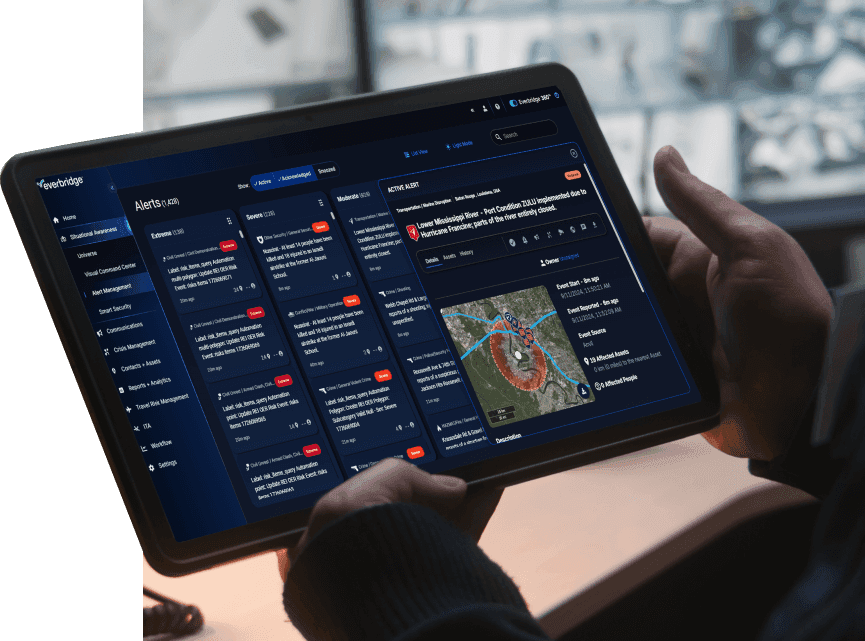When unexpected disruption strikes, how prepared is your business to adapt? Whether it’s a natural disaster, a cyberattack, or a supply chain interruption, unforeseen events can derail operations in an instant. With the increasing frequency and complexity of modern risks, having a robust business continuity plan (BCP) is no longer optional; it’s essential.
Consider our evolving climate. Wildfires and droughts, typical of summers in Australia and the western United States, highlight the increasing prevalence of extreme weather events worldwide. Businesses must now prepare for the unexpected and the danger posed to employee safety, physical assets, and day-to-day business operations during these events.
In this guide, you’ll learn what a business continuity plan is, why it’s critical for organizational success, and how to create an actionable plan with step-by-step guidance. By the end, you’ll have the knowledge to safeguard your business against disruptions and ensure operational resilience.
What is business continuity?
Business continuity refers to an organization’s ability to maintain essential functions during and after a disruption. While it shares similarities with disaster recovery, which focuses on restoring critical systems, business continuity takes a more comprehensive approach. It encompasses people, processes, operations, and technology to ensure minimal downtime and quick recovery.
What is a business continuity plan?
Business continuity plans initially were born out of a need for disaster recovery planning in the early 1970s. At the time, financial companies needed to store backup records away from computers, and recovery efforts were generally the result of disasters like fires and floods. The emphasis was on IT protection, which continued in the 1980s with the proliferation of commercial recovery sites for computer services. As globalization accelerated in the 1990s and computing systems became more complex, organizations realized that a business continuity plan had to encompass much more than technology protection.
Modern business continuity planning integrates disaster recovery, emergency preparedness, and crisis management into a comprehensive strategy. Today, a business continuity plan represents a holistic approach to ensuring organizations can maintain critical operations during any disruption, from natural disasters to cyber attacks.
The scope of business continuity
Business continuity extends across various organizational areas:
- Operations: Ensures uninterrupted delivery of products or services to customers.
- Personnel: Protects employee safety, well-being, and productivity.
- IT Systems: Recovers critical infrastructure and data to sustain business functions.
It is about building resilience, not just reacting to disasters.
Why is business continuity important?
A well-designed BCP is more than a risk management tool; it’s a strategic asset for success. Here’s why every organization needs one:
1. Risk mitigation
Disruptions are costly. According to a FEMA report, roughly 40% of businesses never reopen after a disaster, and 25% fail within a year. With a business continuity plan, you can proactively identify vulnerabilities and minimize financial and operational losses.
2. Customer trust
Maintaining seamless operations during a crisis strengthens your reputation and customer loyalty. Downtime disrupts your services and erodes trust, which can take years to rebuild.
3. Regulatory compliance
Sectors such as finance, healthcare, and manufacturing are required by law to have business continuity plans. Failing to comply can lead to penalties, lawsuits, and loss of contracts.
4. Protecting people
Potential loss of life from fires, pandemics, floods, or even active shooter situations underscores the need for proactive safety strategies.
How to create a business continuity plan
Creating a BCP may seem daunting, but breaking it into manageable steps ensures every crucial element is covered.
1. Assign directly responsible individuals (DRIs)
The first step when preparing a BCP is identifying who needs to lead, create, and execute it. Clearly define roles and responsibilities for team members:
- Identify who will activate the plan.
- Assign leaders to oversee recovery efforts and communication.
- Ensure team members understand their specific obligations.
- Collect essential contact details for key personnel and stakeholders.
- You may also want to include external parties, such as security contractors and facility or property managers.
Gathering this interdisciplinary team will also ensure alignment on roles and responsibilities, so no one is caught off guard during a disruption. Be sure each member has an on-call resource as a backup. That way, should a disruption occur while a BCP lead is away, another subject matter expert can easily step into their role.
2. Conduct a business impact analysis (BIA)
A BIA identifies critical operations and assesses the potential consequences of disruptions. It identifies the risks that could affect your organization and evaluates the degree of harm each could inflict upon its operations, such as regulatory fines, unfulfilled SLAs, or loss of income.
Here’s how:
- List critical functions:
- Examples include order processing, payroll, customer support, and IT infrastructure.
- Assess impact:
- Categorize impacts as financial, operational, legal, or reputational.
- Prioritize:
- Rank functions based on their importance to business continuity and the time required for recovery.
3. Identify and evaluate risks
Analyze potential threats your organization might face. Common risks include:
- Natural disasters (e.g., floods, earthquakes)
- Cybersecurity threats (e.g., ransomware attacks)
- Supply chain disruptions (e.g., delays or shortages)
Evaluate risks based on likelihood and impact, then prioritize high-risk areas first.
4. Develop recovery strategies
Determine the recovery time objective (RTO) for various scenarios. How much time do you have to restore operations to an acceptable level after certain kinds of disruption? For each identified risk, outline a plan to maintain operations:
- Alternate sites:
- Identify remote or backup facilities in case primary locations become inaccessible.
- Backup systems:
- Implement redundant IT infrastructure and off-site data storage.
- Communication plans:
- Use mass notification alerts to keep employees and customers informed during disruptions.
Here, Everbridge High Velocity CEM can play a pivotal role. Purpose-built with advanced AI, High Velocity CEM streamlines recovery plans by proactively addressing risks at scale. It empowers organizations to mitigate disruption, reinforces operational continuity, and enhances resilience. By integrating this system into your strategy, you ensure not only seamless decision-making but also the ability to turn resilience into a powerful competitive advantage in today’s increasingly volatile landscape.
5. Create a communication plan
Effective communication minimizes confusion during a crisis. Your plan should include:
- Internal updates:
- Notify employees of disruptions and share instructions via email, intranet, employee apps, or messaging platforms.
- External communication:
- Inform customers and stakeholders with pre-approved templates for social media, press releases, and emails.
- Tools:
- Use platforms like Everbridge for real-time notifications and updates.
6. Test and update the plan regularly
A plan is only as strong as its last real-world test. Conduct regular simulations and tabletop exercises to assess your BCP’s effectiveness and build your team’s confidence. Gather feedback, identify gaps, confirm technology meets objectives, and make necessary updates.
Ensure your business evaluates your plan against common scenarios such as severe weather, power and network/system outages, cyber-attacks, active assailants, data loss, etc.
Benchmark your plan against others in your industry. You may even want to bring in an external certified business continuity professional to assist in its review.
Key components of a business continuity plan
A comprehensive BCP should include the following:
Emergency response procedures
Clear actions to be taken immediately following a disruption, including evacuation and communication strategies.
Recovery procedures
Outline the steps for restoring critical operations to normal levels to minimize downtime and ensure data availability.
Contact information
Up-to-date details for employees, vendors, and emergency contacts.
Resource inventory
A list of essential tools, equipment, and software needed to continue operations.
Essential business continuity strategy best practices
To ensure your BCP is effective, follow these best practices:
1. Regular training
Familiarize employees with the BC plan through on-site workshops and virtual sessions.
2. Continuous improvement
Encourage feedback and periodic reviews to refine your strategies.
3. Integration with business strategies
Align the continuity plan with your overarching goals to ensure seamless implementation.
4. Cyber resilience
Implement regular penetration testing and robust data backup protocols as part of your resilience strategy.
Real-world examples of business continuity in action
CIBC Mellon utilized Everbridge’s polling capabilities to quickly survey our employees on how they commute to work so they could have a better idea of where employees were coming from, how they traveled, and use that information to better inform where recovery sites should be located.
Everbridge also supported CIBC Mellon by monitoring for potential threats and events and providing immediate, proactive situational awareness, potentially before the direct impact is felt or the first news reports are released about critical events.
Take the next step toward resilience
Creating a business continuity plan is more than an exercise in risk management; it’s a commitment to resilience, trust, and longevity. Whether your organization is facing natural disasters, technological challenges, or geopolitical risks, a robust BCP can mean the difference between recovery and ruin.
Start building your business continuity strategy today with expert support. Request a demo and see how Everbridge empowers organizations to prepare, respond, and thrive in the face of adversity.





